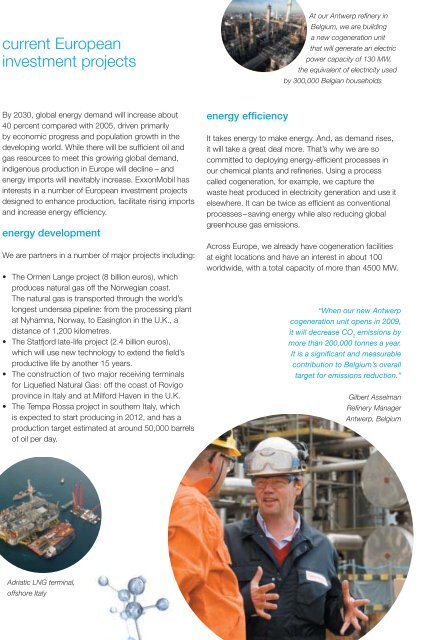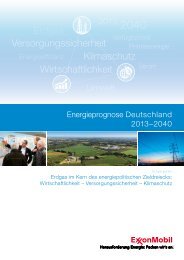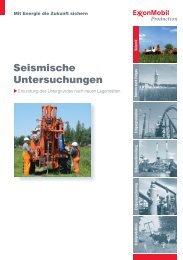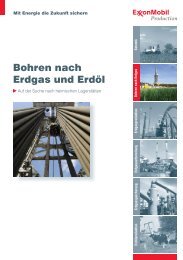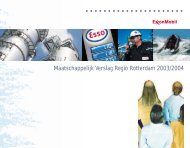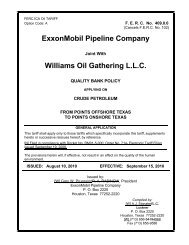ExxonMobil in Europe - ExxonMobil in the UK
ExxonMobil in Europe - ExxonMobil in the UK
ExxonMobil in Europe - ExxonMobil in the UK
You also want an ePaper? Increase the reach of your titles
YUMPU automatically turns print PDFs into web optimized ePapers that Google loves.
current <strong>Europe</strong>an<br />
<strong>in</strong>vestment projects<br />
By 2030, global energy demand will <strong>in</strong>crease about<br />
40 percent compared with 2005, driven primarily<br />
by economic progress and population growth <strong>in</strong> <strong>the</strong><br />
develop<strong>in</strong>g world. While <strong>the</strong>re will be suffi cient oil and<br />
gas resources to meet this grow<strong>in</strong>g global demand,<br />
<strong>in</strong>digenous production <strong>in</strong> <strong>Europe</strong> will decl<strong>in</strong>e – and<br />
energy imports will <strong>in</strong>evitably <strong>in</strong>crease. <strong>ExxonMobil</strong> has<br />
<strong>in</strong>terests <strong>in</strong> a number of <strong>Europe</strong>an <strong>in</strong>vestment projects<br />
designed to enhance production, facilitate ris<strong>in</strong>g imports<br />
and <strong>in</strong>crease energy effi ciency.<br />
energy development<br />
We are partners <strong>in</strong> a number of major projects <strong>in</strong>clud<strong>in</strong>g:<br />
• The Ormen Lange project (8 billion euros), which<br />
produces natural gas off <strong>the</strong> Norwegian coast.<br />
The natural gas is transported through <strong>the</strong> world’s<br />
longest undersea pipel<strong>in</strong>e: from <strong>the</strong> process<strong>in</strong>g plant<br />
at Nyhamna, Norway, to Eas<strong>in</strong>gton <strong>in</strong> <strong>the</strong> U.K., a<br />
distance of 1,200 kilometres.<br />
• The Statfjord late-life project (2.4 billion euros),<br />
which will use new technology to extend <strong>the</strong> fi eld’s<br />
productive life by ano<strong>the</strong>r 15 years.<br />
• The construction of two major receiv<strong>in</strong>g term<strong>in</strong>als<br />
for Liquefi ed Natural Gas: off <strong>the</strong> coast of Rovigo<br />
prov<strong>in</strong>ce <strong>in</strong> Italy and at Milford Haven <strong>in</strong> <strong>the</strong> U.K.<br />
• The Tempa Rossa project <strong>in</strong> sou<strong>the</strong>rn Italy, which<br />
is expected to start produc<strong>in</strong>g <strong>in</strong> 2012, and has a<br />
production target estimated at around 50,000 barrels<br />
of oil per day.<br />
Adriatic LNG term<strong>in</strong>al,<br />
offshore Italy<br />
7 <strong>ExxonMobil</strong> <strong>in</strong> <strong>Europe</strong><br />
energy effi ciency<br />
At our Antwerp refi nery <strong>in</strong><br />
Belgium, we are build<strong>in</strong>g<br />
a new cogeneration unit<br />
that will generate an electric<br />
power capacity of 130 MW,<br />
<strong>the</strong> equivalent of electricity used<br />
by 300,000 Belgian households<br />
It takes energy to make energy. And, as demand rises,<br />
it will take a great deal more. That’s why we are so<br />
committed to deploy<strong>in</strong>g energy-effi cient processes <strong>in</strong><br />
our chemical plants and refi neries. Us<strong>in</strong>g a process<br />
called cogeneration, for example, we capture <strong>the</strong><br />
waste heat produced <strong>in</strong> electricity generation and use it<br />
elsewhere. It can be twice as effi cient as conventional<br />
processes – sav<strong>in</strong>g energy while also reduc<strong>in</strong>g global<br />
greenhouse gas emissions.<br />
Across <strong>Europe</strong>, we already have cogene ration facilities<br />
at eight locations and have an <strong>in</strong>terest <strong>in</strong> about 100<br />
worldwide, with a total capacity of more than 4500 MW.<br />
“When our new Antwerp<br />
cogeneration unit opens <strong>in</strong> 2009,<br />
it will decrease CO 2 emissions by<br />
more than 200,000 tonnes a year.<br />
It is a signifi cant and measurable<br />
contribution to Belgium’s overall<br />
target for emissions reduction.”<br />
Gilbert Asselman<br />
Refi nery Manager<br />
Antwerp, Belgium


